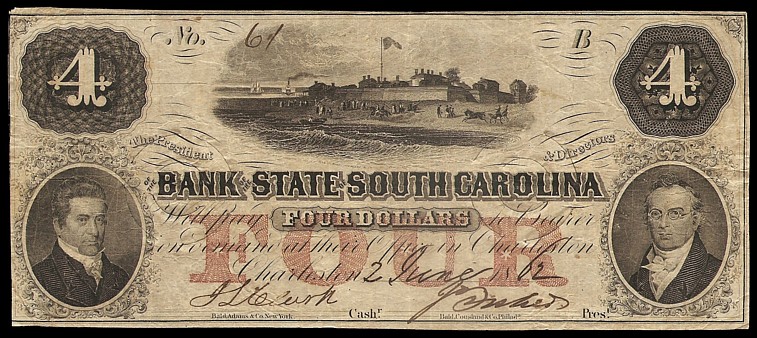South Carolina 1862 $4
Bank of the State of South Carolina, Charleston
Located in South Carolina’s financial center, Charleston, the Bank of the State of South Carolina was chartered on December 18th, 1812 with it’s main purpose being to assist the agricultural interests (plantations) and less for the public in and around Charleston. The primary aim upon starting the bank was to provide low interest loans to planters with administrative processes having an understanding of the local agricultural needs. However, the requirements of running a bank soon brought the need for the institution to deal more broadly in the commercial businesses of the area. It did so with great success, surviving for more than 50 years. With the banks charter came the authorization for it to issue currency and to act as a financial agent of South Carolina.
In 1860 the bank had 4 million dollars in capital, their full resources were valued at 4 million dollars in capital. During the Civil War the Bank of the State of South Carolina was naturally a supporter of the Confederate government, and by 1863, with the increase in Confederate money and wartime inflation, that increased to 15 million dollars, but at least half of it was in confederate funds, which would become worthless when the Civil War ended. With inflation taking it’s toll and the heavy loss of confederate securities, the bank suffered too much and it was denied it’s bid to recharter in 1866.
This banknote has been ‘hammer cancelled’ which can be more readily seen on the back of the banknote in two circular impressions by means of a metal punch. This note was once more scarce in collections, but in 2008 a large number of them were sold by the South Carolina Department of Archives, which had held on to the duplicate issues of banknotes since the end of the civil war.
This note features a center vignette of Fort Moultrie, from which the first ‘official’ shots were fired upon union forces at Fort Sumter. Also prominent are the portraits of Robert Hayne at lower left and Langdon Cheves at lower right.
Robert Hayne was a South Carolina politician who served as mayor of Charleston, Governor of South Carolina, and Senator of South Carolina.
Langdon Cheves was also a prominent South Carolina politician. He was Chairman of the committee of Naval Affairs as well as the Ways and Means commission. He also served as the Speaker of the House succeeding Henry Clay. After his service as House Speaker, he served as the prosident of the Second Bank of the United States from 1819-1823.
This was printed by Adams & Company in New York and Bald, Cousland, & Company, in Philadelphia, both of which are listed on the bottom of this note.

